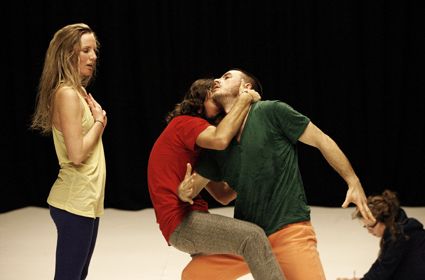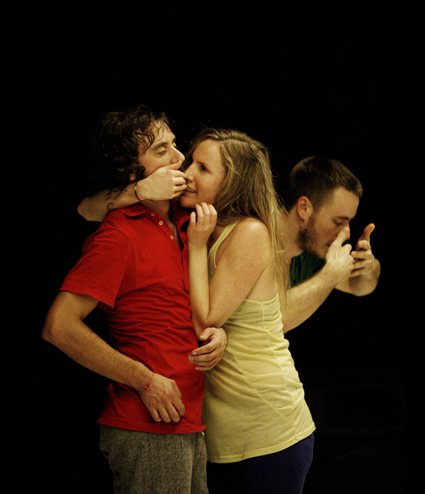present, tense
virginia baxter: luke george, now now now: dance massive

Kristy Ayre, Luke George, Timothy Harvey, audience participant, NOW NOW NOW
photo Jeff Busby
Kristy Ayre, Luke George, Timothy Harvey, audience participant, NOW NOW NOW
HERE AT DANCE MASSIVE, IMPROVISATION IS VERY MUCH ON THE AGENDA AND RESPONSES—LIKE THE QUALITY OF IMPROVISATORY PERFORMANCES OVER A SEASON—ARE WILDLY DIVERGENT. LINES ARE BEING DRAWN. WE’VE NOW SEEN THREE WORKS THAT DEAL WITH THE PROCESS IN DIFFERENT WAYS. IN NO ONE WILL TELL US…, ROSALIND CRISP IN COLLABORATION WITH HANSUELI TISCHHAUSER AND ANDREW MORRISH SHOWS US A BODY SO FINELY TUNED TO SENSATION AND ITS OWN HISTORY THAT ITS MOVEMENT IS LIKE MUSIC, LEAVING US TO VENTURE OUR OWN READINGS. THE FOUR PERFORMERS IN SHAUN MCLEOD’S THE WEIGHT OF THE THING LEFT ITS MARK INTRIGUINGLY PRACTICE ‘PURE’ IMPROVISATION WHILE NEGOTIATING PARTIALLY CHOREOGRAPHED PATHWAYS.
In Luke George’s NOW NOW NOW, we are invited to enter the moment as three improvising performers attempt to pin it down.
White. We remove our shoes to walk the soft, white felted corridor. The fabric extends into the theatre, even to our seats. Above us light is filtered through white Japanese paper. On all sides the white room is bounded by black.
The scene invites concentration. The purity of the setting also highlights the physical presence of the three performers—Luke George, Kristy Ayre and Timothy Harvey.
Costume. In the case of Luke George, this involves a change from his childlike mismatch (yellow shorts, a plastic breast plate, a string of beads dangling a small turtle, and an Indian feather headdress) to track pants and top. The others also change into primary colours until eventually all are in the uniform attire of your average dance ensemble. Not that this is your average dance ensemble.
Warm-up. Lined up, they shout a list of OW words to clear their heads: “Now, cow, vow, bow, chow…” The bland listing becomes warbling chorale.
Research. They move lazily to one corner to gaze at a silent video invisible to the audience. From time to time they pick up on particular movements and mirror them, sometimes together, sometimes apart. We fill in the gaps with imagined dancing. One moment I see a line of men in tails and top hats. They’re gone. Later the trio will utter disjointed phrases seemingly read from the monitor, including:
“I feel I’ve had some funny episodes.”
“I will absolutely indulge that.”
“The most amazing dancer of all time.”
These words and others are repeated and redistributed until they almost become a weirdly naturalistic conversation.
I note we must be 15 minutes in and still in full light.

Luke George, Kristy Ayre, Timothy Harvey, NOW NOW NOW
photo Jeff Busby
Luke George, Kristy Ayre, Timothy Harvey, NOW NOW NOW
Effort. The dancers perform a feat of endurance, jumping and kicking until the sweat streams. They move through awkward, frenetic and apparently unmotivated movements. This is some other kind of dance. I stop taking notes.
Long, utter, emptying blackout.
Interaction. Timothy Harvey approaches an audience member, offers her a set of headphones and an iPod relaying her instructions. She enters the space and for the next five minutes or so becomes a fascinating part of the action, performing small gestures, uttering words, snippets of song—a line from “Singin’ in the Rain.” The others pay her no special attention. She is simply there, part of the scene. Eventually she announces: “A special event!” then leaves. Nothing much happens. Perfect.
Another list. Shouted snatches of sentences. Indolent action followed by wild eruptions suggesting anger or pain, all inflected and articulated with dance moves, all short-lived till someone says, “Enough!”
Sequence in wigs. Synchronised dancing to disco music distracts momentarily from the otherwise engrossing unfamiliarity of the work.
Funny moments. Who said existentialism needed to be angst-ridden? The three appear to be suddenly aware of their surroundings, finding everything surprising or scary.
“Drapes! Drapes!” shouts one as if suddenly shocked by the curtains that frame the space. “Black!” yells another. Luke George is startled to find himself eyeballing the audience. “Downstage!” he gasps “Downstage!” as if crying for help. “Retreating, retreating,” he signals. The others take refuge in geometry, shouting “Triangle!” until George registers and finds safety again in the dancerly threesome.
They stare at us, until the moment when Kristy Ayre says “thank you.”
Applause. Something like an hour has passed.
Watching NOW NOW NOW feels like something new, though not altogether. In the improvisation stakes, it’s about the impetus, the ‘energy’ and whether the impulse hits home, rebounding in a form such that a large enough proportion of the audience can share or interpret it. What is that elusive thing we feel we know when we see it? In NOW NOW NOW, the sense of the live presence is palpable if using a meta-theatre aesthetic for its seduction. In its careful choice of expressive means, there seems more than a hint of possibility. Will it lead to what Helen Herbertson has hoped for, “a kind of re-flowering of really specific, detailed physical language” (quoted in Erin Brannigan’s Platform Paper, Moving Across Disciplines, Currency House, 2011)? On a path shared with Rosalind Crisp’s very different No one will tell us…, NOW NOW NOW takes some big steps in the right direction.
See also realtime’s video interview with Luke George.
–
NOW NOW NOW, choreographer Luke George, performers Kristy Ayre, Timothy Harvey, Luke George, design, production Benjamin Cisterne, dramaturg Martyn Coutts, Music Glass Candy. NOW NOW NOW was originally commissioned by Lucy Guerin Inc; www.dancemassive.com.au
RealTime issue #102 April-May 2011 pg. 16






